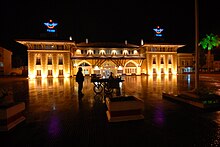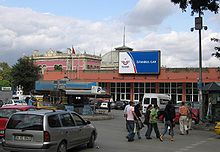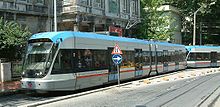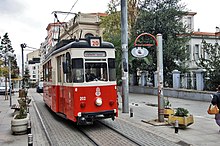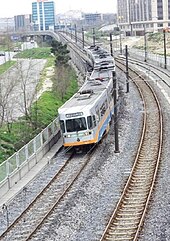Rail transport in Turkey
The rail transport in Turkey is by the State Railway of Turkish State Railways dominated (TCDD). It emerged from the nationalization of private railway companies by the Republic of Turkey in the years 1921–1953. In addition to the railway network, there are various urban rail transport networks in many major Turkish cities, including the megacities of Istanbul , Ankara , Izmir and Bursa .
history
initial situation
Geographical starting point
The main difficulties in developing Turkey by railways are the considerable differences in altitude, its spaciousness and the uneven distribution of the population.
Political situation

In the 19th century the Ottoman Empire fell behind the major European powers in administration, politics, economy and transport. The Ottoman Empire relied on foreign capital as well as foreign technology to build railways. As a result of the Crimean War , foreign influence and interest in economic activities in the Ottoman Empire increased. Initially, a few branch lines were built from the coast to the hinterland, which exclusively followed the economic interests of the investors, facilitated the export of raw materials and the import of goods, but did not take Ottoman interests into account. Such a "railway policy" led to individual connections, but not to a railway network.
After state bankruptcy and a state crisis in the Ottoman Empire in the second half of the 1870s, the Caliph Sultan Abdülhamid II took power. He tried to integrate European achievements into his political program in order to stabilize and modernize his empire. This also included the positive attitude towards railway construction. Abdülhamid II commented on this in his autobiography: “I accelerated the construction of the Anatolian Railway with all my might. The purpose of the railway is to connect Mesopotamia and Baghdad with Anatolia and to reach the Persian Gulf. This will be achieved thanks to German help. Grain that previously spoiled finds markets and our mines gain access to the world market. A bright future is thus prepared for Anatolia. The struggle of the great powers to build the railways on the territory of our empire is threatening and suspicious. Even if the great powers do not admit it: The railways are not only important for the economy, but also for political reasons. "
First lanes
Branch lines
The port city of Izmir was the starting point for British trade and railway construction . From here, starting with the opening of a first section on December 24, 1860, the first railway line via Torbalı and Selçuk to Aydın was built with a length of 73 km. The Ottoman Railway Company (ORC) suffered from financial difficulties from the start, so Aydin was only reached in stages in 1866.
From 1863, a 93 km long route was built from Izmir to the north, to Manisa and Turgutlu . The operating company, known from 1893 as Chemin de fer de Smyrne-Cassaba et Prolongements , was also initially financed with British capital, but later went into French ownership to a group of investors around Georges Nagelmackers . Its first section was opened in 1866 and expanded to Soma and Aleşehir by 1890 . These routes greatly contributed to the upswing of Izmir. They were also of military importance after they were later connected to the Anatolian Railway and the Sea of Marmara , as they facilitated the transport of troops from Istanbul . Other branch lines were built, for example, from the Sea of Marmara to Bursa and from Mersin to Adana .
Long-distance railways
Initial considerations for a railroad crossing the Ottoman Empire from the Mediterranean to the east were made in Great Britain as early as the 1830s in order to facilitate the route to India and to shorten transport times. These considerations receded into the background after the emergence of steam shipping and the opening of the Suez Canal (1869).
The Ottoman state had a similar interest. In order to be able to continue to control the areas in Mesopotamia and Arabia, which are far away from the capital , he needed a railway connection. In 1872 the German engineer Wilhelm Pressel was commissioned to plan a railway network for the Ottoman Empire. The proposal he submitted contained the Baghdad Railway as the central axis for the first time , starting from the capital Istanbul.
This plan was initially implemented with the first construction of a state railway in the Ottoman Empire, which was supposed to advance from Istanbul to Anatolia , a project that got stuck in İzmit after 91 km . This torso then served from 1888 as the starting point for the first long-distance railways of the Ottoman Empire, the Anatolian Railway (CFOA), to Ankara in 1892 and to Konya in 1896 . These routes branched out in Eskişehir . The branch to Konya finally served as the exit of the Baghdad Railway from 1903, on the completion of which until the end of the First World War the activities of the railway construction in the area that subsequently constituted itself as Turkey were concentrated.
The capital for these investments could only be won by the Ottoman state granting a profit guarantee per kilometer of built route and granting the railway companies mining rights over 10 km to the left and right of the railway line. Both led to the idea of building the routes as cheaply as possible, i.e. avoiding engineering structures and preferring meandering routes.
In the European part of the Ottoman Empire, " Rumelia ", 2383 km of standard-gauge lines were created, mostly under the aegis of the Compagnie des Chemins de fer Orientaux , led by Moritz von Hirsch , but some of these were lost again with the progressive disintegration of this part of the Empire before the First World War.
Development in the Republic of Turkey
After the defeat of the Ottoman Empire in World War I , a significant part of what would later become the national territory of Turkey was occupied by Allied troops. In 1920 the Kemalist government took over 926 km of the CFOA route and a section of the Baghdad Railway between Konya and Kelebek from the British military administration and placed them under state administration. On January 25, 1923, the same thing happened with the Istanbul – Izmit route.
October 20, 1921, the operating rights went to the Baghdad Railway between Pozantı in Taurus and Nusaybin (821 km) and the branch paths to Mersin (49 km), İskenderun (59.6 km) and Mardin (25 km) to the Treaty of Ankara on a French company, the Société du Chemin de fer Cilicie - Nord Syrie (CNS), a little later renamed Société d'Exploitation des Chemins de fer Bozanti - Alep - Nissibie et Prolongements (BANP). From 1921, ultimately through the Treaty of Lausanne 1923, the southern side of the railway line of the Baghdad Railway between Karkamış (Jerablus) and Nusaybin was set at 383 km as the border between Turkey and Syria. All station buildings along this route were on the south side, now in Syria, and were named after places south of the route. Turkey, to which the track fell, later erected new station buildings on the north side and named them after places on Turkish territory.
After the founding of the Republic of Turkey in 1923, two basic goals were set in railway policy:
- Transfer of the railways from foreign ownership to a Turkish state railway
- Expansion of the rail network, now exclusively in the interests of Turkey
To implement the program, the Turkish State Railway Türkiye Cumhuriyeti Devlet Demiryolları (TCDD) was established by a law of May 23, 1927. The program was driven forward over a period of 50 years and provisionally completed with the connection to the Iranian rail network in 1975.
nationalization
Law No. 506 of April 22, 1924 approved the purchase of the Anatolian Railway. In 1933 the Adana– Fevzipaşa section was taken over by the TCDD as a further section of the Baghdad Railway , and the BANP dissolved on July 1, 1933. The (Turkish) Südbahn-Aktiengesellschaft Cenup Demiryollari (CD) took its place as the railway infrastructure company for the remaining routes on Turkish territory . The French-Syrian company Société du Chemin de fer Damas-Hamah et Prolongements (DHP) became the operator, i.e. the railway company . The Compagnie des Chemins de fer Orientaux's remaining routes in European Turkey were nationalized in 1937. In 1948 the remaining part of the route up to the border crossing from Nusaybin was also transferred to the TCDD, the CD was dissolved. This completed the nationalization of the railways in Turkey. Up to this point, Turkey had taken over 4,138 km of the route privately.
Expansion of the network
Due to the territorial layout of Turkey, this meant above all the construction of railways in the west-east direction with the connection to the railways in Russia and Persia and the connection of existing routes. By 1950 Turkey had built 3,578 km of new lines. The Second World War had a very inhibiting effect: Of the above-mentioned kilometers of railways built, only 370 km were completed after 1940.
business
network
The Turkish rail network has a length of 12,532 km, of which 1,213 km are high-speed lines . 3,938 km of the network are electrified , and operating safety is guaranteed by signals over 5,008 km . The network is divided into three parts:
- European network , west of Istanbul, with routes to Greece and Bulgaria ;
- Central network in Anatolia . These two networks have been linked by the Marmaray Tunnel since 2013 ;
- the route from Van to Iran, separated from the central network by Lake Van . Coming from Ankara, the track ends in Tatvan . A train ferry and regular buses run between Tatvan and Van .
Until the mid-1950s, the railroad was the main mode of transport in Turkey. Since then, traffic has made it less and less important. Rail traffic was neglected, the expansion of the roads had priority. Between 1950 and 1997 the road network grew by 80%, but the rail network only increased by 11%.
The length of the rail network is around 11,000 km today, almost 20% of which are electrified . The railways account for only 10% of total Turkish traffic (as of 1999), and only 4% for travelers. There the absolute numbers are 38% below those of 1950, for freight traffic by 60%.
Four sub-networks of the overall network are electrified, so that the electrical traction there takes place in island mode : The route from the Bulgarian border to Istanbul-Sirkeci, Istanbul- Haydarpaşa- Ankara, the vicinity of Izmir and the section İskenderun-Malatya- Divriği .
In 2014, the Turkish high-speed network consisted of the Sincan - Eskişehir (221 km), Polatli - Konya (212 km) and Eskişehir - Pendik (155 km) routes .
passenger traffic
The passenger traffic of the TCDD is comparatively sparse. The average travel speed is usually below that of the rather dense network of bus services. However, the railroad fares are around half the bus fares. Printed timetables have not been available for around 15 years and only some of the connections are published on the Internet. A timetable brochure has been published for regional traffic in the Izmir area (up to 300 km away) since spring 2007. Otherwise, the timetables are only posted at the train stations .
- Price examples June 2007:
- Adana-Mersin approx. 50 km - 3.50 YTL (approx. 2 €)
- Malatya-Fevzipasa approx. 200 km - 9.50 YTL (approx. 5.50 €)
- Adana-Elazig, approx. 500 km - 17 YTL (approx. 10 €)
- Fevzipasa-Afyon (couchette), approx. 800 km - 22.25 YTL (approx. € 13)
High speed traffic
TCDD has so far procured twelve multiple units from CAF in Spain for high-speed traffic. The trains were transferred by rail from Spain to Turkey. They are named HT65000 . Each unit has a "Business Class" with 55 seats in the 2 + 1 seating arrangement and 354 seats in the "First Class " in the 2 + 2 seating arrangement. With this, the TCDD is partially giving up the complete one-class operation (" Pullman ") introduced a few years ago . The buffet area of the multiple units has eight seats. The doors are arranged in the middle of the car. The multiple units can also be used in double traction .
Long-distance transport
As a rule, one long-distance train runs on serviced routes per day, usually as a night connection; A modern diesel railcar runs between Adana and Kayseri during the day . However, some routes are served even less frequently. The exception is the Istanbul – Ankara route, which offers several day and night connections per day. Due to the construction work to connect the Marmaray Tunnel, these currently no longer begin and end in Istanbul itself.
The wagons used in long-distance transport are usually very modern. The traditional class system was abolished here and replaced by the one-size-fits-all “Pullman” class. Seating cars with the seating arrangement 1 + 2 offer the same level of comfort as first class open- plan cars on Central European railways - albeit at much lower prices. In addition, sleeping cars (two- bed compartments, WL A) and couchette cars (four-bed compartments, Ac) are offered in night connections .
Dining cars are also rare in long-distance transport. Since the trains usually only stop briefly, the "buffets" at the stations can only rarely be used, for example when changing locomotives. Unlike in Russia, there are no dealers on the platforms , and some of them get into moving trains from time to time.
Cross-border traffic
Cross-border passenger traffic to and from Turkey is sparse. From the west there is a daily night train from Sofia to Istanbul, in summer with through coaches to Bucharest, but due to construction work in Istanbul the train ends at the suburban station in Halkalı , the Istanbul Sirkeci station is currently without passenger traffic. The rail border crossing to Armenia has been closed for political reasons since 1993, the one to Syria since 2012 due to the raging civil war there. The route to Iran is currently only served by freight traffic, the weekly Ankara – Tehran passenger train was discontinued after several attacks on the railway line in south-east Turkey at the instigation of the Iranian railway, as the safety of passengers was no longer guaranteed. The rail link to Georgia ( Kars – Akhalkalaki – Tiflis – Baku line ) was opened in October 2017, but only freight trains have been running so far, and passenger traffic is expected to commence in the foreseeable future.
Regional traffic
"Regional trains" run on some sections of the route, but usually only one pair of trains a day. Older types of high-comfort cars are also used here. However, they are not redrawn, so that trains are on the way that are made up exclusively of first-class cars or second-class couchette cars. The “Pullman” price applies to all of these cars.
Projects
- Ankara – İstanbul high-speed line (the first section went into operation in 2009) (for trains up to 250 km / h)
- Ankara – Konya high-speed line (opening August 24, 2011)
- Ankara – Sivas high-speed line (bypassing Kayseri)
- Branch of the Ankara – Istanbul line to Bursa.
- Renewal of the S-Bahn ( Egeray ) in Izmir.
- Tunneling under the Bosphorus in Istanbul. An extension to Kapikule on the Bulgarian border is planned.
- Kars – Akhalkalaki – Tbilisi – Baku railway line - a joint project between Turkey and Georgia and Azerbaijan .
Public transport
The first urban local transport in what is now Turkey was put into operation as early as 1869 in the form of a horse-drawn tram in Istanbul. There were horse trams in Izmir too. Both cities introduced electric trams , starting with Istanbul on the European side in 1913 . After the Second World War, as in many other countries, they were increasingly viewed as an obstacle to road traffic and shut down. In Izmir, operations were discontinued in 1954, and the electric trams disappeared from the European part of Istanbul in 1961. The last time trams were discontinued in the Asian part of Istanbul in 1966 in favor of buses. For many years, urban rail transport in Turkey consisted exclusively of the Istanbul Tünel , an underground funicular railway. The renaissance of the tram , which began in France in the 1980s, led to the fact that in Turkey, too, rail traffic is once again viewed as a solution to metropolitan traffic problems. There are now new tram companies in Istanbul, Konya , Gaziantep , Eskişehir , Samsun , Kayseri and Antalya . At the same time, subways were built in Ankara, Istanbul, Izmir, Bursa and Adana .
A commuter train , -Transport in Turkey banliyö Trenleri referred, there are in Istanbul (both on the European and on the Asian side), Izmir and Ankara - operated there electric - and between Adana, Tarsus and Mersin with diesel trains .
Istanbul
The largest city in Turkey has an extensive rail network. In addition to the S-Bahn operated by the TCDD, there are several other rail-bound local transport services, but all of them with different incompatible technology. Istanbul is still a long way from having a closed, clear local transport network. The lines are mostly designed to bring workers from the suburbs to the center, some lines are mostly used by tourists.
Istanbul suburban train
The S-Bahn runs into the hinterland on both sides and connects the districts and towns there with the Istanbul city center train stations. On the European side with a route length of 30 km and on the Asian side with a route length of 44 km. Both parts of the network are to be connected with the Marmaray tunnel, but so far the tunnel has been operated as an isolated operation.
Istanbul Metro
The first line of the Istanbul Metro , the M2 line , opened in 2000. It is around 23.5 kilometers long and has 13 stations. The M2 line runs from the northern district of Hacıosman via the Levent financial center and Taksim Square to Şişhane. A southern extension to Yenikapı went into operation in 2014. In the meantime three more lines have been opened with the line M3 , the line M4 and the line M6 . Further routes are under construction and should be opened in the coming years.
Hafif Metro (Istanbul)
The Hafif Metro Istanbul is a light rail in the west of Istanbul. Their first line M1 was opened in 1989 and has been continuously expanded since then. The network currently consists of two different lines, M1 and T4 . Since 2002, the M1 has been connecting the airport with the city center over a length of around 20 km. There is also a branch line that is to be expanded further into the western suburbs. The T4 opened in 2007 and runs from Topkapı to Sultançiftliği. In Topkapı there is a transition to the tram line T1 and to the İETT operated Metro buses (Turk. Metrobüs ).
Trams
There are now three tram lines in the greater Istanbul area. Two of them are operated by İstanbul Ulaşım.
The T1 line runs right through historic Istanbul (route length almost 20 kilometers). The opening took place on June 13, 1992 on the Beyazıt - Yusufpaşa section. The line was extended in several sections to the Zeytinburnu district (January 31, 1994). The extension from Sirkeci station to Eminönü (April 20, 1996) and then on to Kabataş also brought the connection via the new Galata Bridge to the districts north of the Golden Horn. Since February 4, 2011, line T1 has continued from Zeytinburnu to Bağcılar; thereby the former line T2 from Zeytinburnu to Bağcılar was dissolved.
Tram line T3 is a museum tram between Kadıköy and Moda in the Asian part of the city. It opened on November 1, 2003. It is a one-way, 2.6 kilometer long ring route that follows an impressive course through the hilly and narrow streets of the district. The route is served by various Gotha ( T57 , T59 ) and Reko cars (TZ 70), almost all of which come from Jenaer Nahverkehr GmbH. The line designation 20 can be read on the vehicles (however, this is not a valid line designation).
The Nostaljik Tramvay is a 1.6 kilometer long, historic tram without a specific line name, which runs in the former Pera Street and today's İstiklal Caddesi in the Beyoğlu district between Tünel Square and Taksim Square. The line, which uses historic vehicles, was opened on April 12, 1990 and has been operated by İETT ever since .
Funiculars
The Tünel -Bahn between Karaköy and Tünel-Platz in the Beyoğlu district on the hill is a 574-meter-long underground funicular with no line name, which was opened on January 12, 1875. It is the third oldest subway in the world.
The Füniküler Kabataş – Taksim , which has the line number F1, leads from Kabataş on the Bosporus up to Taksim Square . This underground funicular was opened on June 30, 2006 and connects the end points, which are about half a kilometer apart, in 110 seconds.
Izmir
Izmir suburban train
The first suburban traffic was set up on the railway lines departing from Izmir soon after they went into operation. The resulting network, which started at the two terminal stations Alsancak and Basmane , was served by steam-hauled trains until 1983, which were then replaced by used diesel locomotives of the DB class V 100 . In 2007 the system was thoroughly modernized and reopened with electric multiple units. These run a total of 76 km to the suburbs of Cumaovası and Aliağa .
Metro Izmir
The metro in Izmir was built from 1995. The first section was opened in 2000. The system, which previously consisted of one line, has been extended several times since then. The north-east of the city center to Bornova was built using an earlier suburban railway.
literature
- Benno Bickel: Bagdad Railway Timeline , in: Jürgen Franzke (Ed.): Bagdad Railway and Hedjaz Railway. German Railway History in the Middle East , Nuremberg 2003, ISBN 3-921590-05-1 , pp. 160–162.
- Johannes Müller: Syria and the Hejaz Railway . Steam and Travel / Overseas Railways 1/1989.
- Erika Preissig, Günther Klebes: Railway construction and railway projects in the Orient and the economic and political goals pursued with them , in: Yearbook for Railway History 21 (1989), pp. 43-102.
Web links
- TCDD website (Turkish)
Individual evidence
- ^ Translation from the English text on the TCDD homepage
- ^ Benno Bickel, Karl-Wilhelm Koch, Florian Schmidt: Steam under the half moon. The last few years of steam operation in Turkey . Verlag Röhr, Krefeld 1987, ISBN 3-88490-183-4 , p. 10
- ^ Bickel, Zeittafel, p. 161
- ↑ Müller, p. 43
- ^ NN: High Speed Expansion in Turkey Shapes the Future of Travel . In: HaRakevet 116 (March 2017). ISSN 0964-8763, p. 13, reproduced from: European Railway Review 22 (2016), issue 5, p. 113f.
- ↑ http://www.tcdd.gov.tr/tcdding/tarihce_ing.html
- ↑ http://www.brooksreports.com/index.php?archive=&lang=en&cat=&search=&viewreport=147
- ↑ armradio.am: Conductor waiting for Armenia-Turkey train for 22 years , June 29, 2015, accessed on April 21, 2018
- ↑ irna.ir: Iran railways: Train subject to attack in Turkey not Iranian , July 25, 2016, accessed on April 21, 2018
- ↑ azertag.az: goods train traveling on the route Baku-Tbilisi-Kars, arrived in Mersin , November 4, 2017. Retrieved on April 21, 2018
- ↑ Note on the opening (turntable online)
- ↑ Website of the project ( Memento of the original from December 24, 2005 in the Internet Archive ) Info: The archive link was automatically inserted and not yet checked. Please check the original and archive link according to the instructions and then remove this notice. (English, with map of the route)
- ↑ http://www.eurailpress.de/news/infrastructure/single-view/news/tuerkei-hgv-strecke-nach-bulgarien-geplant.html
- ^ Tram views of Asia , accessed October 3, 2015

